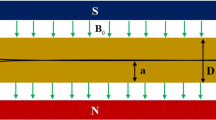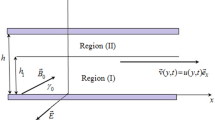Abstract
In this paper we study a turbulent pipe flow of a weakly electrical conducting fluid subjected to a homogeneous magnetic field which is applied perpendicular to the flow. This configuration forms the basis of a so-called electromagnetic induction flow meter. When the Hartmann number is small so that modification of flow by the Lorenz force can be neglected, the influence of the magnetic field results only in a spatially and temporally varying electric potential. The magnitude of the potential difference across the pipe is then proportional to the flow rate and this constitutes the principle of the flow meter. In this study the flow and electric potential are computed with help of a numerical flow simulation called Large-Eddy Simulation (LES) to which we have added an equation for the electrical potential. The results of the LES have been compared with experiments in which the electric potential is measured as a function of time at several positions on the circumference of the pipe. Both the experimental and numerical results for the mean potential at the pipe wall agree very well with an exact solution that can be obtained in this particular case of a homogeneous magnetic field. Furthermore, it is found that fluctuations in the electric potential due to the turbulence, are small compared to the velocity fluctuations. Based on the results we conclude that electrical-magnetic effects in pipe flow can be accurately computed with LES.
Similar content being viewed by others
References
Tennekes, H. and Lumley, J.L., A First Course in Turbulence. The MIT Press, Cambridge, MA (1972).
Shercliff, J.A., The Theory of Electromagnetic Flow-Measurements. Cambridge University Press, Cambridge (1962).
Bevir, M.K., O'Sullivan, V.T. and Wyatt, D.G., Computation of electromagnetic flow meter characteristics from magnetic field data. J. Phys. D. Appl. Phys. 14 (1981) 373–388.
Tsinober, A., Kit, E. and Teitel, M., On the relevance of the potential-difference method for turbulence measurements. J. Fluid Mech. 175 (1987) 447–461.
Eggels, J.G.M., Unger, F., Weiss, M.H., Westerweel, J., Adrian, R.J., Friedrich R. and Nieuwstadt, F.T.M., Fully developed turbulent pipe flow: A comparison between direct numerical simulation and experiment. J. Fluid Mech. 268 (1994) 175–209.
Hinze, J.O., Turbulence. McGraw-Hill, New York (1975).
den Toonder, J.M.J. and Nieuwstadt, F.T.M., Reynolds number effects in a turbulent pipe flow for low to moderate Re. Phys. Fluids 9 (1997) 3398–3409.
Piomelli, U., Moin, P. and Fertziger, J.H., Model consistency in large eddy simulation of turbulent channel flow. Phys. Fluids 31 (1988) 1884–1888.
Williams, E.J., The induction of e.m.f.s in a moving fluid by a magnetic field and its application to an investigation of the flow of liquids. Proc. Phys. Soc., London 42 (1930) 466–480.




